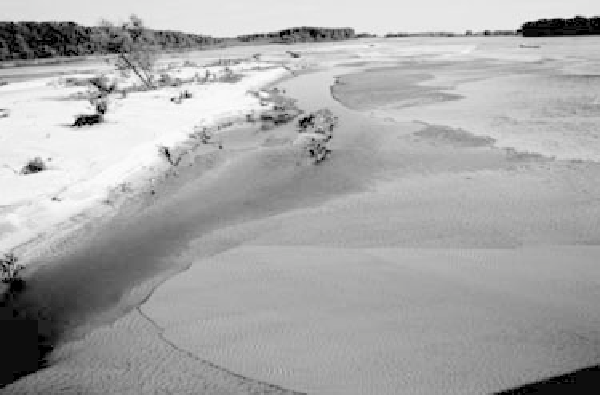Geoscience Reference
In-Depth Information
they are noncohesive, cohesive, or composite. Bank
undercutting by the river leads to collapse along planes
formed by soil shrinkage. Clay banks may fail along rota-
tional slides. In both cases, failure and collapse occur pref-
erentially during falling river stage in response to changing
porewater levels and pore pressures. The combined
processes of outer bank erosion and inner bank accretion
over the surface of a bar lead to whole channel migration.
Channel bends may grow, migrate, and rotate with time,
frequently leading to the formation of
cutoffs
as the chan-
nels take shortcut routes across meander necks during
high discharges. Periodic bend migration and bar accre-
tion in response to major floods lead to the production of
a characteristic arcuate topography of
scroll bars
on bar sur-
faces (Fig. 6.65).
At the zone of river
confluences
, experimental and
field studies reveal the existence of strong vertical axis
vortical structures of Kelvin-Helmholtz type (Fig. 6.67;
Section 4.9.6), which scour deeply into the underlying
substrate. The depth of scour may reach several times that
of the bankfull depths of the contributing tributaries, so
that in the case of major rivers, the highly mobile scours
may reach up to 30 m below low water level.
Adjacent to river channels are swathes of periodically
flooded
wetlands
whose environmental well-being has
often been neglected in the cause of floodplain cultivation
and habitation. Data on the magnitude of deposition dur-
ing flooding events are sparse, but careful trapping experi-
ments, comparisons of upstream and downstream gauging
station records, and radiometric dating of floodplain cores
reveal that a surprisingly high proportion (30-70%) of
upstream suspended load may be deposited on the flood-
plain reach during flooding. Most sand is dumped on the
levees
very close to the channel margins (Fig. 6.68). The net
effect of repeated flooding is the production of an
alluvial
ridge
, whose topography of levees and active and aban-
doned meander loops stand above the general floodplain
level. The observed falloff in mean net deposition rate,
r
, at
any distance,
z
, from the edge of the channel over the levee
to the floodplain margin is most simply given by power-law
expressions like
r
Outer
bank
t
1
t
1
t
2
t
2
t
3
t
3
Extent of bar deposit
underwater
Surface flow vector
near-bed flow vector
Lines of equal bed shear stress
t
1
>
t
2
>
t
3
1)
b
, where
a
is the maximum
net deposition rate at the edge of the channel belt, and
b
is
an exponent that describes the rapidity with which the rate
of deposition decreases with distance from the meander
belt. The coefficients vary according to factors such as
climate, river size, timing of flood, and sediment load.
a
(
z
Inner
bank
t
1
t
1
Fig. 6.65
Helical flow cells due to radial acceleration occur in
all
channel bends. They explain the inward movement of sediment to
form the point or channel bar. The lessening magnitude inward of
the flow vectors explains the observed inward trend to finer sedi-
ment grain size.
Fig. 6.66
Braided reach of the Platte River, Nebraska during low flow. The wide, shallow channel divides and rejoins around channel bars.
Note vegetated bar to left indicative of short term stability and the active, migrating bars under shallow water to the right.

















Search WWH ::

Custom Search